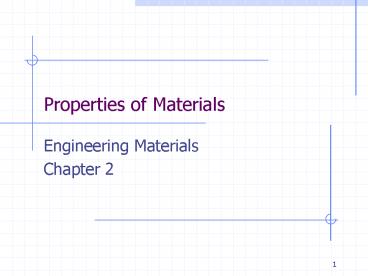Properties of Materials - PowerPoint PPT Presentation
1 / 16
Title:
Properties of Materials
Description:
Chemical measured in a laboratory. Physical mainly non-destructive ... Engineering (Fig 2-15) True (Fig 2-16) Work or strain hardening. Significance of exponent ... – PowerPoint PPT presentation
Number of Views:61
Avg rating:3.0/5.0
Title: Properties of Materials
1
Properties of Materials
- Engineering Materials
- Chapter 2
2
Chapter 2 Goals
- Identify important properties for material
selections - Compare properties among different material
groups - Understand testing procedures data
- Identify thoroughly understand mechanical
properties of - Stiffness
- Strength
- Toughness
3
Chapter 2 Purpose
- Identify and discuss the properties often used in
making key material selections - Understand how these properties are measured
- Understand how to interpret data from the various
test methods
4
Chapter 2 Introduction
- Establish a vocabulary of properties
- Show how these properties apply to different
material groups - In some instances, the testing technique will be
described in detail
5
2.1 The Property Spectrum
- Choosing a material is similar to buying a car
- Primary categories of materials shown in Fig 2-1
- Chemical measured in a laboratory
- Physical mainly non-destructive
- Mechanical response of an applied force
- Manufacturing Shape and surface features
- Look at terms under headings for each material
- Much cross-over in terms, i.e. thermal expansion
6
2.1 The Property Spectrum
- International Standards Organization (ISO)
certification - Part of process is to document testing procedures
- Various Standards Organizations have developed
standard test procedures - ASTM, ISO, ANSI, CEN, DIN, BSI
7
2.2 Chemical Properties
- Composition
- Metals - of elements
- Polymers monomer with chain length
- Mixture filler information
- Ceramics stoichiometric makeup
- Sometimes volume fraction of 2 or more compounds
- Binder information
- Phases present, crystal structure, grain size,
porostiy, etc. - Composites details of matrix and reinforcement
- Volume fractions
- Orientation of reinforcement
- Try to avoid using trade names!
8
2.2 Chemical Properties
- Microstructure
- Metals grain size, phases present, heat
treatment, inclusions - How is grain size measured? (Fig 2-2, 2-3)
- Metallography microtomy
- Crystal Structure Stereospecificity
- X-ray diffraction SC, BCC, FCC, HCP
- Polymers semicrystalline
- Stereospecificity isotactic, syndiotactic,
atactic - Metals BCC v. FCC Which tends to be brittle at
low temperatures? - Corrosion Resistance degradation of a material
by reaction with the environment
9
2.3 Physical Properties
- Thermal properties
- Thermal conductivity Btu or W/(mK)
- Basic equation for steady-state heat flow
(Ficks 1st Law) - Thermal expansion in/(inF) or cm/(cmF)
- Al v. Steel
- Takes place on the volume of material (Donut
example) - Polymers
- Maximum use temperature
- Heat distortion temperature
- Water absorption
- Electrical properties
- Resistivity, r (inverse of K) mWcm or Wm
- Conductivity inverse of r
- Metals v. Polymers or ceramics
10
2.3 Physical Properties
- Magnetic properties
- Permeability, retentivity, hysteresis loss,
coercivity, intrinsic induction, etc. - Ferromagnetism Fe, Ni, Co, Gd, Dy
- Measure of response to a magnetic field
- Flux density, B (B-H curve, Fig 2-6)
- Importance and application of hysteresis loop
- What materials?
- Gravimetric mass of materials
- Density specific gravity (used with cost)
- Porosity theoretical v. apparent
- Optical properties
11
2.4 Mechanical Properties (Fig 2-7)
- Stress (Fig 2-8,2-9) N/m2 or Pa
- Elastic v. plastic
- Elastic modulus, E
- Strain
- Hookes Law (Fig 2-10)
- Example p. 37
- Materials Fig 2-11
- Tensile test (Fig 2-12, 2-13, 2-14)
- Gage marks for strain measurement
- Extensometer
- Proportional limit, yield stress (0.2), UTS
- Ductility - elongation, area reduction
12
2.4 Mechanical Properties
- Two s-e curves
- Engineering (Fig 2-15)
- True (Fig 2-16)
- Work or strain hardening
- Significance of exponent
- Poissons ratio (Fig 2-17)
- 0.2 0.35
- Stress-strain testing
- Table 2-1, 2-2
- Resilience elastic energy absorption
- Fig 2-18, 2-19
13
2.4 Mechanical Properties
- Shear properties
- Fig 2-20
- Shear modulus (Fig 2-21)
- Hardness tests (Fig 2-22 2-26)
- Mohs, Brinell, Rockwell, Knoop, Vickers
- Shore Durometer
- Impact tests (Fig 2-27)
- Impact strength J/m3
- NDT or DBTT (Fig 2-28)
- Long-term Serviceability
- Endurance limity, Creep, Stress rupture (Fig 2-29
2-31) - Fracture mechanics
- Fracture Toughness, Kc
- Table 2-4
14
2.5 Manufacturing Considerations
- Surface finish (Fig 2-32)
- Roughness, waviness (Fig 2-34)
- Profilometers (Fig 2-33)
- Cutoff width
- Surface texture (Fig 2-35 2-38)
- Size and shape
- Stock tolerances
15
Summary Critical Concepts
- Glance through glossary of terms
- Review bullet points on p. 67
16
Case History
- Stiffness-driven designs
- Load v. efficient shape
- Example windshield wiper design
- Thin-walled round steel tubes v. aluminum































